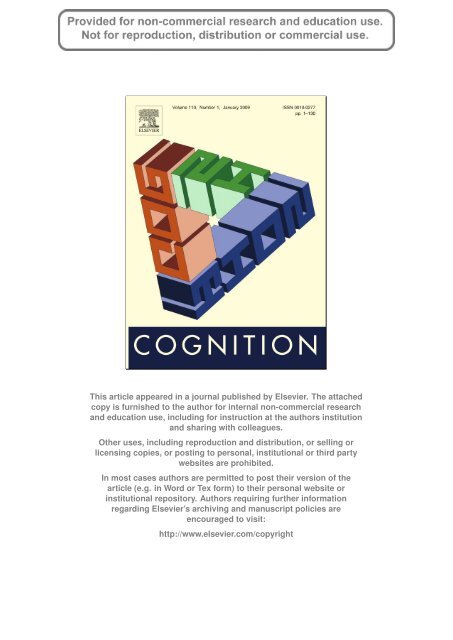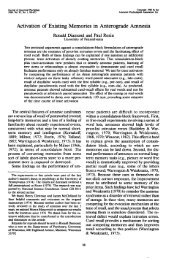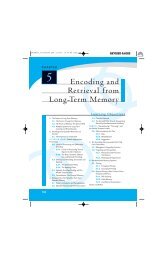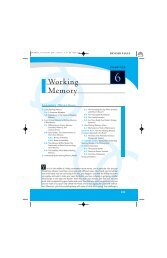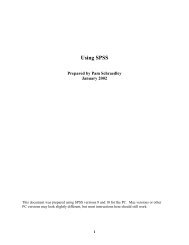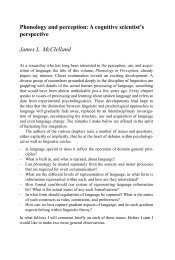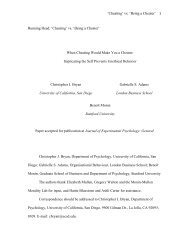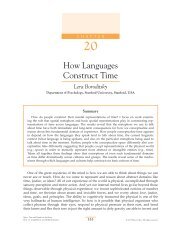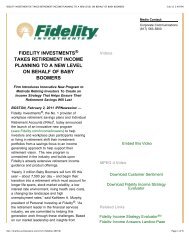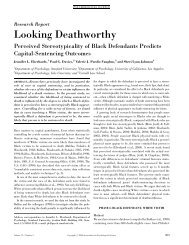Embodied and disembodied cognition: Spatial perspective-taking
Embodied and disembodied cognition: Spatial perspective-taking
Embodied and disembodied cognition: Spatial perspective-taking
Create successful ePaper yourself
Turn your PDF publications into a flip-book with our unique Google optimized e-Paper software.
This article appeared in a journal published by Elsevier. The attached<br />
copy is furnished to the author for internal non-commercial research<br />
<strong>and</strong> education use, including for instruction at the authors institution<br />
<strong>and</strong> sharing with colleagues.<br />
Other uses, including reproduction <strong>and</strong> distribution, or selling or<br />
licensing copies, or posting to personal, institutional or third party<br />
websites are prohibited.<br />
In most cases authors are permitted to post their version of the<br />
article (e.g. in Word or Tex form) to their personal website or<br />
institutional repository. Authors requiring further information<br />
regarding Elsevier’s archiving <strong>and</strong> manuscript policies are<br />
encouraged to visit:<br />
http://www.elsevier.com/copyright
Author's personal copy<br />
<strong>Embodied</strong> <strong>and</strong> <strong>disembodied</strong> <strong>cognition</strong>: <strong>Spatial</strong> <strong>perspective</strong>-<strong>taking</strong><br />
Barbara Tversky a, *, Bridgette Martin Hard b<br />
a Department of Psychology, Stanford University, Bldg. 420, Stanford, CA 94305-2130, United States<br />
b Department of Psychology, University of Oregon, United States<br />
article info<br />
Article history:<br />
Received 29 July 2008<br />
Revised 10 October 2008<br />
Accepted 17 October 2008<br />
Keywords:<br />
Perspective-<strong>taking</strong><br />
Self<br />
Other<br />
Egocentric<br />
<strong>Spatial</strong> reasoning<br />
1. Introduction<br />
abstract<br />
The mind is locked in a body that, at any time, occupies<br />
a specific place <strong>and</strong> faces a specific direction. These undeniable<br />
facts form part of the basis for embodied <strong>cognition</strong>.<br />
It is natural, then, to think that an egocentric <strong>perspective</strong><br />
on space has primacy: that is, that an egocentric <strong>perspective</strong><br />
is immediate, <strong>and</strong> that <strong>taking</strong> other <strong>perspective</strong>s requires<br />
extra mental effort. Indeed, the premise of<br />
egocentric primacy pervades theories of spatial <strong>cognition</strong><br />
(e.g., Golledge, 1992; Hart & Moore, 1973; Levelt, 1989;<br />
Piaget & Inhelder, 1956; Pick & Lockman, 1981; Shelton &<br />
McNamara, 1997). Yet, to navigate in <strong>and</strong> communicate<br />
about the world, other representations of space are<br />
needed. The primacy of egocentric <strong>perspective</strong> has been<br />
challenged by research showing that rats, monkeys, <strong>and</strong><br />
people on first encountering an environment immediately<br />
form multiple representations of space, in particular, allocentric<br />
representations (e.g., Graziano & Gross, 1994;<br />
Mou, McNamara, Valiquette, & Rump, 2004; O’Keefe &<br />
Nadel, 1978; Tipper & Behrmann, 1996; Tversky, Lee, &<br />
Mainwaring, 1999). In an egocentric <strong>perspective</strong>, objects<br />
* Corresponding author. Tel.: +1 650 725 2440; fax: +1 650 725 5699.<br />
E-mail address: btversky@stanford.edu (B. Tversky).<br />
0010-0277/$ - see front matter Ó 2008 Elsevier B.V. All rights reserved.<br />
doi:10.1016/j.<strong>cognition</strong>.2008.10.008<br />
Cognition 110 (2009) 124–129<br />
Contents lists available at ScienceDirect<br />
Cognition<br />
journal homepage: www.elsevier.com/locate/COGNIT<br />
Although people can take spatial <strong>perspective</strong>s different from their own, it is widely<br />
assumed that egocentric <strong>perspective</strong>s are natural <strong>and</strong> have primacy. Two studies asked<br />
respondents to describe the spatial relations between two objects on a table in photographed<br />
scenes; in some versions, a person sitting behind the objects was either looking<br />
at or reaching for one of the objects. The mere presence of another person in a position<br />
to act on the objects induced a good proportion of respondents to describe the spatial relations<br />
from that person’s point of view (Experiment 1). When the query about the spatial<br />
relations was phrased in terms of action, more respondents took the other’s <strong>perspective</strong><br />
than their own (Experiment 2). The implication of action elicits spontaneous spatial <strong>perspective</strong>-<strong>taking</strong>,<br />
seemingly in the service of underst<strong>and</strong>ing the other’s actions.<br />
Ó 2008 Elsevier B.V. All rights reserved.<br />
are represented or described with respect to the body,<br />
using terms like front, back, left, <strong>and</strong> right. In an allocentric<br />
<strong>perspective</strong>, objects are represented or described with respect<br />
to each other, using an environmental frame of reference<br />
such as north–south–east–west. Indeed, people often<br />
spontaneously choose allocentric <strong>perspective</strong>s to describe<br />
environments, even those experienced only from exploration<br />
(e.g., Taylor & Tversky, 1996).<br />
Egocentric <strong>and</strong> allocentric <strong>perspective</strong>s are not the only<br />
possible <strong>perspective</strong>s on space. Importantly, there is my<br />
(egocentric) <strong>perspective</strong> <strong>and</strong> yours, self <strong>and</strong> other. People<br />
are inherently social beings. Consequently, people find<br />
themselves in situations requiring <strong>taking</strong> another’s <strong>perspective</strong>.<br />
One such situation occurs commonly in conversation;<br />
for example, when one person asks another where<br />
something is. In this kind of situation, people typically<br />
favor the other’s <strong>perspective</strong> to their own, (e.g., Mainwaring,<br />
Tversky, Ohgishi, & Schiano, 2003; Schober, 1993,<br />
1995). But because in these situations, the descriptions<br />
were designed for others, the preference for describing spatial<br />
relations from the other’s <strong>perspective</strong> does not imply<br />
that <strong>taking</strong> the other’s <strong>perspective</strong> is immediate or primary.<br />
Could there be spatial situations in which people spontaneously<br />
adopt another’s <strong>perspective</strong> rather than their<br />
own, even when not communicating to other person? Con-
versation is only one example of a social situation that<br />
encourages <strong>perspective</strong>-<strong>taking</strong>. Another situation is interaction<br />
of bodies rather than voices. Even simple social<br />
interactions, such as accepting a cup of coffee from someone<br />
or negotiating the crowd on the street, require anticipating<br />
the actions of others in order to coordinate our<br />
own. Anticipating others’ actions may also help to underst<strong>and</strong><br />
those actions even without the intent or immediate<br />
need to respond. Watching a tennis serve, observing how<br />
to buy a train ticket in a foreign country, studying an effective<br />
public speaker are examples. Taking the <strong>perspective</strong> of<br />
the other may be effective both for planning responses to<br />
others’ actions <strong>and</strong> for underst<strong>and</strong>ing <strong>and</strong> learning them.<br />
Thus, it is possible that simply seeing another person in a<br />
scene near objects in grasping range will elicit some spontaneous<br />
<strong>perspective</strong>-<strong>taking</strong>.<br />
Would the mere presence of another in a scene with the<br />
potential for action elicit <strong>taking</strong> that person’s <strong>perspective</strong>,<br />
without any dem<strong>and</strong> to communicate to that person? This<br />
is the first question addressed here, in a simple, direct task.<br />
A questionnaire included a photograph of a bottle <strong>and</strong> a<br />
book on a table, with or without a person behind the table<br />
(see Fig. 1), below which was a question: In relation to the<br />
bottle, where is the book? Would participants respond<br />
using their own right <strong>and</strong> left, or use right <strong>and</strong> left with respect<br />
to the other’s <strong>perspective</strong>? The expectation was that<br />
the presence of another person in the scene, especially one<br />
related to <strong>and</strong> likely to use the objects whose spatial relations<br />
are queried, would induce some participants to take<br />
the other person’s <strong>perspective</strong> rather than their own.<br />
If <strong>perspective</strong>-<strong>taking</strong> is related to underst<strong>and</strong>ing or anticipating<br />
another’s actions, then calling attention to action by<br />
phrasing a question about the spatial relations between the<br />
objects in terms of action should increase <strong>perspective</strong>-<strong>taking</strong>.<br />
Thus a second study compared static questions like that<br />
of the first experiment to action questions.<br />
2. Study 1: mere presence of another elicits spatial<br />
<strong>perspective</strong>-<strong>taking</strong><br />
Does the mere presence of a person in a scene with two<br />
salient objects placed on a table near the person cause<br />
some respondents to spontaneously take the spatial <strong>perspective</strong><br />
of the other person rather than their own?<br />
2.1. Method<br />
One hundred Stanford <strong>and</strong> 90 University of Oregon<br />
undergraduates were presented with one of the three pho-<br />
Author's personal copy<br />
B. Tversky, B.M. Hard / Cognition 110 (2009) 124–129 125<br />
Fig. 1. Scenes used in Studies 1 <strong>and</strong> 2. Participants in Study 1 were shown one of the three scenes, depending on condition: reaching scene (a), looking scene<br />
(b), or no person scene (c). Participants in Study 2 were shown only the scene of an actor reaching for an object (a).<br />
tographs in Fig. 1 <strong>and</strong> asked: ‘‘In relation to the bottle,<br />
where is the book?” The no person (n = 64) photograph<br />
showed a bottle <strong>and</strong> a book on a table. Two other photographs<br />
included a person sitting behind the table, either<br />
looking (n = 64) at the book or reaching (n = 62) for it. In both<br />
studies, the photograph <strong>and</strong> question were part of a large<br />
set of unrelated questionnaires students completed for<br />
course credit, at Stanford, a paper booklet, <strong>and</strong> at University<br />
of Oregon, online. There were no differences between Stanford<br />
<strong>and</strong> University of Oregon undergraduates in any of the<br />
results in either study so the results were combined.<br />
2.2. Results<br />
The responses were scored as self <strong>perspective</strong> if the answer<br />
provided was from the viewer’s viewpoint, other if<br />
the answer was from the person in the scene’s viewpoint,<br />
<strong>and</strong> neutral if the answer gave spatial information from<br />
neither <strong>perspective</strong>, for example, ‘‘next to.” Examples of responses<br />
scored as self include: ‘‘right,” ‘‘on the right,”<br />
‘‘about a foot to the right,” ‘‘to the right of the bottle from<br />
my <strong>perspective</strong>.” Examples scored as ‘‘other” include:<br />
‘‘left,” ‘‘to his left,” ‘‘to the left according to the way he is<br />
facing,” ‘‘to the left (relative to his <strong>perspective</strong>).” Four participants<br />
(one other <strong>perspective</strong> <strong>and</strong> 3 self <strong>perspective</strong>)<br />
used both <strong>perspective</strong>s in their response, writing, for<br />
example, ‘‘my right, his left.” In those cases, the first <strong>perspective</strong><br />
mentioned determined the coding category.<br />
Examples scored as neutral include: ‘‘across the table,”<br />
‘‘to the side,” ‘‘parallel,” ‘‘a foot away.” In describing spatial<br />
relations, people often avoid using left <strong>and</strong> right (e.g., Mainwaring<br />
et al., 2003) because these terms are more difficult<br />
than other spatial relation terms, like front, across, or near<br />
(e.g., Franklin & Tversky, 1990).<br />
Scored responses were converted into two binary variables<br />
for analysis: one variable was coded 1 if the response<br />
was self <strong>perspective</strong> <strong>and</strong> 0 if it was not; the second variable<br />
was coded 1 if the response was other <strong>perspective</strong> <strong>and</strong> 0 if<br />
it was not. These variables were each analyzed with a oneway<br />
Analysis of Variance, followed by two planned contrasts:<br />
one comparing the no person photograph to the<br />
photographs depicting a person (looking <strong>and</strong> reaching)<br />
<strong>and</strong> another comparing the looking to the reaching photograph.<br />
For all analyses, the criterion for significance was alpha<br />
level less than .05. We report partial eta squared (g 2 p )<br />
as an estimate of effect size for significant ANOVA effects,<br />
<strong>and</strong> Cohen’s d for significant t-test effects.<br />
The photograph viewed affected the frequency of other<br />
<strong>perspective</strong>, F(2,187) = 8.26, p < .05, g 2 = .08. As evident
100%<br />
90%<br />
80%<br />
70%<br />
60%<br />
50%<br />
40%<br />
30%<br />
20%<br />
10%<br />
0%<br />
from Fig. 2, when the scene included a person, about a<br />
quarter of participants adopted the viewpoint of the person<br />
in the scene (M = .25, SEM = .04). This was significantly<br />
higher than for the scene with no person (M = .03,<br />
SEM = .02), t(187) = 3.93, p < .001, d = .57. There were no<br />
differences in other <strong>perspective</strong> responses between the<br />
reaching scene (M = .29, SEM = .06) <strong>and</strong> the looking scene<br />
(M = .22, SEM = .05), t(187) = 1.09, p = .28. Similarly, the<br />
proportion of self <strong>perspective</strong> responses was affected by<br />
the photograph participants viewed, F(2,187) = 4.27,<br />
p < .05, g 2 = .04. Self <strong>perspective</strong> responses were significantly<br />
lower for the scenes including a person (M = .54,<br />
SEM = .04) than the scenes that did not (M = .72,<br />
SEM = .06), t(187) = 2.43, d = .36, but did not differ significantly<br />
for looking (M = .61, SEM = .06) versus reaching<br />
photographs (M = .47, SEM = .06), t(187) = 1.65, p = .10.<br />
Thus, the presence of a person in a scene did prompt a significant<br />
number of spatial descriptions from the other’s<br />
point of view.<br />
Few participants, 17 out of 126, not out of 148 (13%) of<br />
those responding to the photographs that included another<br />
person, were explicit as to whose <strong>perspective</strong> they<br />
adopted. That is, they used expressions that specified<br />
whose <strong>perspective</strong>, such as ‘‘his,” ‘‘my,” ‘‘to the man’s left,”<br />
or ‘‘to the left according to the way he is facing.” More than<br />
twice as many of those <strong>taking</strong> the other’s <strong>perspective</strong> made<br />
explicit reference to whose <strong>perspective</strong> they used, 9 out of<br />
32 (28%) compared to those <strong>taking</strong> their own <strong>perspective</strong>, 8<br />
out of 68 (12%), a difference that is significant the Chisquare<br />
(df = 1) = 4.13, p < .05. This suggests that more of<br />
those adopting the other’s <strong>perspective</strong> were aware of the<br />
ambiguity of the spatial reference terms. Nevertheless,<br />
the vast majority of respondents <strong>taking</strong> their own or the<br />
other’s <strong>perspective</strong> saw no need to specify whose <strong>perspective</strong><br />
they were <strong>taking</strong>, thus presupposing that others would<br />
share that <strong>perspective</strong>.<br />
A very small number, 9 out of 126 (7%) participants who<br />
viewed a photograph with a person in it seemed to be<br />
using the person in the photograph like a l<strong>and</strong>mark, typically<br />
in redundant descriptions, for example, ‘‘under the<br />
man’s h<strong>and</strong>, to his left of the bottle” or ‘‘to the right of<br />
Author's personal copy<br />
126 B. Tversky, B.M. Hard / Cognition 110 (2009) 124–129<br />
Percentage of Responses<br />
No Actor<br />
Scene<br />
Looking<br />
Scene<br />
Reaching<br />
Scene<br />
the bottle, but to the left of the person sitting,” but also<br />
‘‘by the man’s left h<strong>and</strong>” <strong>and</strong> ‘‘to the right of the man.”<br />
2.3. Discussion<br />
Neutral<br />
Self<br />
Actor<br />
Fig. 2. In Study 1, mean response from an other, self, or neutral <strong>perspective</strong> as a function of scene.<br />
Students viewed a photograph of a person seated at a<br />
table looking at or reaching for one of two objects or a photograph<br />
of the table <strong>and</strong> objects alone. They were asked to<br />
report the spatial relations between the two objects. When<br />
the scene included a person, about a quarter of the students<br />
described the spatial relations from that person’s<br />
point of view. The others either took a neutral <strong>perspective</strong><br />
(around 30%), avoiding the difficult terms, right <strong>and</strong> left, or<br />
took their own <strong>perspective</strong>, avoiding reversing right <strong>and</strong><br />
left. Given the difficulty of using right <strong>and</strong> left from one’s<br />
own <strong>perspective</strong>, reversing right <strong>and</strong> left to take another’s<br />
<strong>perspective</strong> is notable. Why would a quarter of the participants<br />
go to this effort? Unlike the Schober (1993, 1995)<br />
<strong>and</strong> Mainwaring et al. (2003) studies, in this study, there<br />
was no communication partner whose spatial <strong>perspective</strong><br />
<strong>and</strong> cognitive load were to be considered. What’s more,<br />
the implicit recipient of the spatial description is the<br />
experimenter, whose <strong>perspective</strong> is the same as the<br />
participants’.<br />
Some may be concerned that the <strong>perspective</strong>-<strong>taking</strong><br />
may be attributable in part to task dem<strong>and</strong>s. Some participants<br />
may have thought the experimenter wished them to<br />
use the person in their responses. However, the person can<br />
be included in the response without <strong>taking</strong> the person’s<br />
<strong>perspective</strong>, specifically, using the person as a l<strong>and</strong>mark.<br />
The book’s location could have been described as right or<br />
left of the person, with respect to the viewer’s <strong>perspective</strong>,<br />
in accordance with Levinson’s relative <strong>perspective</strong><br />
(Levinson, 1996), <strong>and</strong> a small number of respondents did<br />
just that. Nevertheless, it is possible that some participants<br />
did perceive a dem<strong>and</strong> to take the other’s <strong>perspective</strong>. One<br />
goal of the next experiment is to test that conjecture.<br />
Given that the implied message recipient shares the<br />
participant’s <strong>perspective</strong>, that participants want to finish<br />
the task easily <strong>and</strong> quickly, <strong>and</strong> that using left <strong>and</strong> right<br />
from another’s <strong>perspective</strong> is effortful, the frequency of
spontaneously adopting the opposing <strong>perspective</strong> of the<br />
other is impressive, even if it is not a majority. Seeing a<br />
person eying or reaching for an object may generate an<br />
expectation that the person will act on the objects. The desire<br />
to underst<strong>and</strong> or anticipate the person’s actions may<br />
encourage <strong>taking</strong> the <strong>perspective</strong> of the person likely to<br />
act. This account could lead to the prediction that the<br />
reaching scene should elicit more <strong>perspective</strong>-<strong>taking</strong> than<br />
the looking scene, which was not the case. However, the<br />
suggestion of action may have been strong enough in the<br />
looking photograph. Calling further attention to action by<br />
asking a question implying action may serve as a stronger<br />
suggestion of action, <strong>and</strong> elicit more <strong>perspective</strong>-<strong>taking</strong>.<br />
This possibility is examined in the second study.<br />
Supposing that instead of a person in the scene there<br />
had been an inanimate object such as a coffee pot or a doll;<br />
would participants spontaneously take the ‘‘point of view”<br />
of the inanimate object? This seems improbable. When<br />
asked to take the <strong>perspective</strong> of inanimate objects, people<br />
easily do so (e.g., Bryant, Tversky, & Franklin, 1992) but it is<br />
as if they are imagining themselves in that position. If, as<br />
tested in the next experiment, emphasizing action increases<br />
<strong>perspective</strong>-<strong>taking</strong>, then the likelihood of spontaneously<br />
adopting the <strong>perspective</strong> of an inanimate object<br />
would seem even lower.<br />
3. Study 2: highlighting action increases <strong>perspective</strong><strong>taking</strong><br />
The presence of a person in a scene prompts some viewers<br />
to adopt the person’s <strong>perspective</strong> in describing spatial<br />
relations in the scene. Both underst<strong>and</strong>ing action <strong>and</strong><br />
responding to it might be facilitated by <strong>taking</strong> the <strong>perspective</strong><br />
of an actor. Would asking a question that calls attention<br />
to action increase this effect? Here, participants<br />
viewed the photograph of the person reaching for one of<br />
two objects <strong>and</strong>, as before, were asked about the location<br />
of one object relative to the other. The influence of action<br />
on spatial <strong>perspective</strong> was tested by questions that called<br />
attention either to action or to static information. If<br />
emphasizing action affects encoding of spatial <strong>perspective</strong>,<br />
then a question drawing attention to action should promote<br />
<strong>perspective</strong>-<strong>taking</strong> more than a question drawing<br />
attention to static information. The task dem<strong>and</strong> conjecture<br />
was tested by questions that did or did not call attention<br />
to the other person.<br />
3.1. Method<br />
Thirty-three Stanford University <strong>and</strong> 121 University of<br />
Oregon undergraduates were presented with the photograph<br />
in Fig. 1 showing a person at a table reaching for<br />
one of the two objects on the table. Participants were asked<br />
one of four questions about the spatial relations between<br />
the objects. Two of the questions mentioned action: ‘‘In<br />
relation to the bottle, where does he place the book?”<br />
(n = 39) <strong>and</strong> ‘‘In relation to the bottle, where is the book<br />
placed?” (n = 37). The other two questions implied no action:<br />
‘‘In relation to the bottle, where is his book?”<br />
(n = 38) ‘‘In relation to the bottle, where is the book?”<br />
Author's personal copy<br />
B. Tversky, B.M. Hard / Cognition 110 (2009) 124–129 127<br />
(n = 40). Note that one version of each question type mentioned<br />
the person in the scene <strong>and</strong> the other did not. The<br />
photograph <strong>and</strong> question were embedded with unrelated<br />
questionnaires <strong>and</strong> completed for course credit.<br />
3.2. Results <strong>and</strong> discussion<br />
As before, the responses were scored as self <strong>perspective</strong><br />
if the answer was from the viewer’s viewpoint, other if the<br />
answer was from the person viewpoint, <strong>and</strong> neutral if the<br />
answer was from neither <strong>perspective</strong>, for example, ‘‘next<br />
to.” Five participants (4 self <strong>and</strong> 1 other <strong>perspective</strong>) specified<br />
both <strong>perspective</strong>s. Again, the first <strong>perspective</strong> given<br />
determined the coding category. Binary variables were<br />
again created based on the scored responses. Each of these<br />
variables was analyzed using a factorial Analysis of Variance<br />
with question types as factors: mentioning action<br />
crossed with mentioning the person in the scene.<br />
When the spatial questions referred to action, the frequency<br />
of <strong>taking</strong> the other’s <strong>perspective</strong> increased. Fig. 3<br />
shows that more participants took the other person’s <strong>perspective</strong><br />
when the question referred to action (M = .50,<br />
SEM = .06) than when it referred to static information<br />
(M = .33, SEM = .05), F(1,150) = 4.35, p < .05, g 2 = .03. Notably,<br />
when the question mentioned action, approximately<br />
50% of the participants took the other’s <strong>perspective</strong> <strong>and</strong><br />
only 20% took their own <strong>perspective</strong>. In contrast, more,<br />
but by no means all, participants took a self <strong>perspective</strong><br />
when the question referred to static (M = .44, SEM = .06)<br />
than to action information (M = .22, SEM = .05),<br />
F(1,150) = 8.37, p < .01, g 2 = .05. The proportion of participants<br />
<strong>taking</strong> each <strong>perspective</strong> for the static questions replicated<br />
the findings of Study 1. Altogether, calling attention<br />
to action increased the frequency of adopting the other’s<br />
<strong>perspective</strong> but calling attention to the person did not.<br />
In contrast to referring to action, referring to the person<br />
in the scene had no effects on the tendency to take the<br />
other’s (F(1,150) < 1) or one’s own <strong>perspective</strong><br />
(F(1,150) = 1.48, p = .23). There was a significant interaction<br />
on the frequency of adopting a self <strong>perspective</strong>,<br />
F(1,150) = 8.65, p < .01, g 2 = .05. When the actor was mentioned<br />
in the question, referring to action yielded fewer<br />
self <strong>perspective</strong> responses (M = .08, SEM = .04) than static<br />
phrasing (M = .50, SEM = .08). However, when the actor<br />
was not mentioned, referring to action yielded equivalent<br />
numbers of self <strong>perspective</strong> responses (M = .38, SEM = .08)<br />
as static phrasing (M = .38, SEM = .08). This interaction<br />
did not hold true for the proportion of other <strong>perspective</strong> responses,<br />
F(1,150) < 1. Overall, referring to the person in the<br />
scene did not increase the proportion of other <strong>perspective</strong><br />
responses.<br />
As before, the spatial descriptions were sometimes<br />
more complex than simple ‘‘to the right.” Twenty-one percent<br />
of the respondents were explicit as to whose <strong>perspective</strong><br />
they adopted, higher than in the first study. In contrast<br />
to the first study, the proportion of respondents who specified<br />
their <strong>perspective</strong> did not depend on the <strong>perspective</strong><br />
chosen; the proportion of explicit <strong>perspective</strong> was essentially<br />
the same for self (27%) <strong>and</strong> other (30%), Chi-square<br />
(df = 1) = .07, p = .79. Proportion of those making their <strong>perspective</strong><br />
explicit also did not differ depending on whether
the question specified action (20%) or static information<br />
(23%), Chi-square (df = 1) = .26, p = .61. However, more participants<br />
made their <strong>perspective</strong> explicit (27%) when<br />
responding to questions that referred to the actor than<br />
when responding to questions that did not refer to the actor<br />
(16%), an effect that was marginally reliable, Chi-square<br />
(df = 1) = 3.12, p = .08. Six participants overall used the person<br />
as a l<strong>and</strong>mark, half of those in redundant descriptions.<br />
4. General discussion<br />
100%<br />
90%<br />
80%<br />
70%<br />
60%<br />
50%<br />
40%<br />
30%<br />
20%<br />
10%<br />
0%<br />
In the present studies, participants were asked to describe<br />
spatial relations between salient objects in a scene.<br />
The mere presence of a person in the scene with the potential<br />
of interacting with the objects encouraged many respondents<br />
to take that person’s spatial <strong>perspective</strong>, describing<br />
the locations of the objects from the other’s right or left, despite<br />
the cognitive difficulty of using <strong>and</strong> reversing left <strong>and</strong><br />
right. Phrasing the question about the spatial relations between<br />
the objects in terms of action caused virtually half<br />
the respondents to take the other’s <strong>perspective</strong>, more than<br />
double the number who took their own <strong>perspective</strong>. In contrast<br />
to other studies showing <strong>perspective</strong>-raking in spatial<br />
descriptions (e.g., Mainwaring et al., 2003; Schober, 1993,<br />
1995), the present participants were not explicitly or implicitly<br />
communicating with the other. To the extent that there<br />
was implicit communication in the task, it was to the experimenter,<br />
who shared the participant’s <strong>perspective</strong>.<br />
Why do many viewers spontaneously take the <strong>perspective</strong><br />
of another person, <strong>and</strong> why does calling attention to<br />
action augment that effect? When a scene has objects<br />
<strong>and</strong> no person, answering the question is simply a matter<br />
of determining the spatial relations between the objects,<br />
<strong>and</strong> the most prominent referent is one’s own body. However,<br />
when the scene includes a person, even though the<br />
question is only about the spatial relations between the<br />
objects, it may be preceded by an attempt to make sense<br />
of the entire scene, especially the role of the person in<br />
the scene. That sense-making would increase to the extent<br />
that the person is perceived to be potentially interacting<br />
with the objects, <strong>and</strong> even more, when the question im-<br />
Author's personal copy<br />
128 B. Tversky, B.M. Hard / Cognition 110 (2009) 124–129<br />
Percentage of Responses<br />
Actor<br />
Mentioned<br />
No Actor<br />
Mentioned<br />
Actor<br />
Mentioned<br />
No Actor<br />
Mentioned<br />
Action Question Static Question<br />
Neutral<br />
Self<br />
Actor<br />
Fig. 3. In Study 2, mean response from an other, self, or neutral <strong>perspective</strong> as a function of question type.<br />
plies action. Underst<strong>and</strong>ing the role of the person in interaction<br />
with the objects would be helped by <strong>taking</strong> that<br />
person’s <strong>perspective</strong>.<br />
Effective social interaction depends on <strong>perspective</strong>-<strong>taking</strong>.<br />
Social interactions entail responding to the actions of<br />
others, whether those actions are verbal or physical. Anticipating<br />
how to behave in social situations may be promoted<br />
by <strong>perspective</strong>-<strong>taking</strong>, by considering the actions<br />
of others from their point of view. Speaking to others,<br />
underst<strong>and</strong>ing others, <strong>and</strong> reacting to others all require<br />
some comprehension of what the world looks like to them.<br />
Perspective-<strong>taking</strong> is undoubtedly an effective strategy in<br />
social situations <strong>and</strong> might occur spontaneously in anticipation<br />
of social interaction. Consequently, seeing another<br />
person in a scene might prompt thinking about the world<br />
from the other’s <strong>perspective</strong>.<br />
Might describing the spatial situation from the other’s<br />
point of view be mediated by the mirror neuron system<br />
(e.g., Gallese, Keysers, & Rizzolatti, 2004; Rizzonlatti,<br />
Fadiga, Gallese, & Fogassi, 1995)? Social interaction is a<br />
layered phenomenon as are <strong>perspective</strong>-<strong>taking</strong> <strong>and</strong> the<br />
mirror neuron system. Thinking about the world from another’s<br />
point of view can be literal, that is, spatial, or figurative,<br />
that is, metaphoric. Here, we examined literal<br />
spatial <strong>perspective</strong>-<strong>taking</strong>, finding that it increased when<br />
action was implied. That kind of <strong>perspective</strong>-<strong>taking</strong> was<br />
interpreted as subserving underst<strong>and</strong>ing potential action.<br />
The phenomena observed here were high-level <strong>and</strong> cognitive,<br />
reflected in <strong>and</strong> affected by language. The kinds of<br />
metaphoric <strong>perspective</strong>-<strong>taking</strong> underlying underst<strong>and</strong>ing<br />
another’s political views or emotional state may be very<br />
different, the former likely to be expressed in appropriate<br />
inferences <strong>and</strong> the latter in empathetic facial expressions.<br />
It would be an interesting if surprising extension of<br />
embodied <strong>cognition</strong> if attitudinal or emotional <strong>perspective</strong>-<strong>taking</strong><br />
also promoted spatial <strong>perspective</strong>-<strong>taking</strong>.<br />
Although all may involve forms of neural resonance, evidence<br />
suggests that emotional <strong>and</strong> action <strong>perspective</strong>-<strong>taking</strong><br />
activate quite different brain systems (Gallese et al.,<br />
2004; Jackson, Meltzoff, & Decety, 2006; Lamm, Batson, &<br />
Decety, 2007). Assuming the other’s position in space is
likely to improve action underst<strong>and</strong>ing, but does not seem<br />
relevant to underst<strong>and</strong>ing attitudes or emotions.<br />
Collectively, the present findings show that the mere<br />
presence of another person in a scene changes the way<br />
people think about the spatial relations among objects in<br />
the scene. Although not all participants took the <strong>perspective</strong><br />
of the person in the scene instead of their own <strong>perspective</strong>,<br />
a majority did when the question focused<br />
attention on action. Given that there were no dem<strong>and</strong>s, explicit<br />
or implicit, to take the other’s <strong>perspective</strong>, this result<br />
discounts claims that an egocentric <strong>perspective</strong> is primary<br />
<strong>and</strong> natural (e.g., Eppley, Morewedge, & Keysar, 2004; Hart<br />
& Moore, 1973; Levelt, 1989; Piaget & Inhelder, 1956). On<br />
the contrary, in some situations, <strong>taking</strong> the other’s <strong>perspective</strong><br />
appears to be more natural <strong>and</strong> spontaneous than<br />
<strong>taking</strong> one’s own.<br />
Much has been said about embodied <strong>cognition</strong> (e.g.,<br />
Barsalou, Niedenthal, Barbey, & Ruppert, 2003; Borghi,<br />
Glenberg, & Kaschak, 2004). The present results show that<br />
the deep meaning of embodied <strong>cognition</strong> is that it enables<br />
<strong>disembodied</strong> thought (e.g., Tversky, 2005). Here, people<br />
overcame their own embodied position in space to take<br />
an imaginary one, they escaped the entrapment of minds<br />
in bodies <strong>and</strong> bodies in views on space through imagination.<br />
What’s surprising <strong>and</strong> significant is that people spontaneously<br />
take other <strong>perspective</strong>s despite the very real<br />
presence of their own.<br />
Acknowledgment<br />
This research was partially supported by a National Research<br />
Service Award from the National Institute of Health<br />
to Bridgette Martin Hard.<br />
References<br />
Barsalou, L. W., Niedenthal, P. M., Barbey, A. K., & Ruppert, J. A. (2003).<br />
Social embodiment. In B. H. Ross (Ed.), The psychology of learning <strong>and</strong><br />
motivation (pp. 43–92). San Diego: Academic Press.<br />
Borghi, A. M., Glenberg, A. M., & Kaschak, M. P. (2004). Putting words in<br />
<strong>perspective</strong>. Memory <strong>and</strong> Cognition, 32, 863–873.<br />
Bryant, D. J., Tversky, B., & Franklin, N. (1992). Internal <strong>and</strong> external<br />
spatial frameworks for representing described scenes. Journal of<br />
Memory <strong>and</strong> Language, 31, 74–98.<br />
Eppley, N., Morewedge, C. K., & Keysar, B. (2004). Journal of Experimental<br />
Social Psychology, 40, 760–768.<br />
Author's personal copy<br />
B. Tversky, B.M. Hard / Cognition 110 (2009) 124–129 129<br />
Franklin, N., & Tversky, B. (1990). Searching imagined environments.<br />
Journal of Experimental Psychology: General, 119, 63–76.<br />
Gallese, V., Keysers, C., & Rizzolatti, G. (2004). A unifying view of the basis<br />
of social <strong>cognition</strong>. Trends in Cognitive Sciences, 8, 396–403.<br />
Golledge, R. G. (1992). Place re<strong>cognition</strong> <strong>and</strong> wayfinding: Making sense of<br />
space. Geoforum, 23, 199–214.<br />
Graziano, M. S. A., & Gross, C. G. (1994). Mapping space with neurons.<br />
Current Directions in Psychological Science, 3, 164–167.<br />
Hart, R. A., & Moore, G. T. (1973). The development of spatial <strong>cognition</strong>. In<br />
R. M. Downs & D. Stea (Eds.), Image <strong>and</strong> environment (pp. 246–288).<br />
Chicago: Aldine.<br />
Jackson, P. L., Meltzoff, A. N., & Decety, J. (2006). Neural circuits involved<br />
in imitation <strong>and</strong> <strong>perspective</strong>-<strong>taking</strong>. NeuroImage, 31, 429–439.<br />
Lamm, C., Batson, C. D., & Decety, J. (2007). The neural substrate of<br />
human empathy – Effects of <strong>perspective</strong>-<strong>taking</strong> <strong>and</strong> cognitive<br />
appraisal: An event-related fMRI study. Journal of Cognitive<br />
Neuroscience, 19, 42–58.<br />
Levelt, W. J. M. (1989). Speaking: From intention to articulation. Cambridge:<br />
MIT Press.<br />
Levinson, S. (1996). Frames of reference <strong>and</strong> Molyneux’s question: Crosslinguistic<br />
evidence. In P. Bloom, M. A. Peterson, L. Nadel, & M. F.<br />
Garrett (Eds.), Space <strong>and</strong> Language (pp. 109–169). Cambridge: MIT<br />
Press.<br />
Mainwaring, S. D., Tversky, B., Ohgishi, M., & Schiano, D. J. (2003).<br />
Descriptions of simple spatial scenes in English <strong>and</strong> Japanese. <strong>Spatial</strong><br />
Cognition <strong>and</strong> Computation, 3, 3–42.<br />
Mou, W., McNamara, T. P., Valiquette, C. M., & Rump, B. (2004). Allocentric<br />
<strong>and</strong> egocentric updating of spatial memory. Journal of Experimental<br />
Psychology: Learning Memory <strong>and</strong> Cognition, 30, 142–157.<br />
O’Keefe, J., & Nadel, L. (1978). The hippocampus as a cognitive map. New<br />
York: Oxford University Press.<br />
Piaget, J., & Inhelder, B. (1956). The child’s conception of space. London:<br />
Routledge <strong>and</strong> Kegan Paul.<br />
Pick, H. L., Jr., & Lockman, J. J. (1981). From frames of reference to spatial<br />
representations. In L. S. Liben, A. H. Patterson, & N. Newcombe (Eds.),<br />
<strong>Spatial</strong> representation <strong>and</strong> behavior across the life span: Theory <strong>and</strong><br />
application (pp. 39–60). New York: Academic Press.<br />
Rizzonlatti, G., Fadiga, L., Gallese, V., & Fogassi, L. (1995). Premotor cortex<br />
<strong>and</strong> the re<strong>cognition</strong> of motor actions. Cognitive Brain Research, 3,<br />
131–141.<br />
Schober, M. F. (1993). <strong>Spatial</strong> <strong>perspective</strong>-<strong>taking</strong> in conversation.<br />
Cognition, 47, 1–24.<br />
Schober, M. F. (1995). Speakers, addressees, <strong>and</strong> frames of reference.<br />
Whose effort is minimized in conversations about locations?<br />
Discourse Processes, 20, 219–247.<br />
Shelton, A. L., & McNamara, T. P. (1997). Multiple views of spatial<br />
memory. Psychonomic Bulletin <strong>and</strong> Review, 4, 102–106.<br />
Taylor, H. A., & Tversky, B. (1996). Perspective in spatial descriptions.<br />
Journal of Memory <strong>and</strong> Language, 35, 371–391.<br />
Tipper, S. P., & Behrmann, M. (1996). Object-centered not scene-based<br />
visual neglect. Journal of Experimental Psychology: Human Perception<br />
<strong>and</strong> Performance, 22, 1261–1278.<br />
Tversky, B. (2005). <strong>Embodied</strong> <strong>and</strong> <strong>disembodied</strong> <strong>cognition</strong>. In A. Berthoz &<br />
R. Recht (Eds.), Les Espaces de l’Homme (pp. 161–184). Paris: Odile<br />
Jacob.<br />
Tversky, B., Lee, P. U., & Mainwaring, S. (1999). Why speakers mix<br />
<strong>perspective</strong>s. Journal of <strong>Spatial</strong> Cognition <strong>and</strong> Computation, 1, 399–412.


